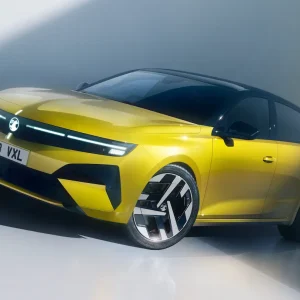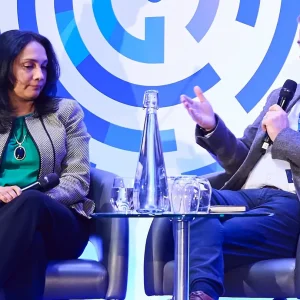Some problems facing the used EV market could be due to the models generally being larger than most buyers would like.
That’s according to Matthew Freeman, managing consultant for data firm Cap HPI, who said consumers’ general unfamiliarity with EVs – especially compared with those working in the industry – was also an issue.
Speaking at the Vehicle Remarketing Association’s (VRA) annual seminar, Freeman (pictured) discussed how EV residual values had fallen by 42% over the past 12 months, and explained that his company had a number of theories about what could be behind this.
He said: “One of which is that these are in a way the wrong kind of cars. If you look at a typical non-EV, the normal profile is about a third of the market is superminis, and about a third of the market is lower-medium. The rest of the marketplace is city cars, supercars, luxury cars, executive cars, and traditional upper-medium.
“If you look at EVs, you can see we have far too many upper-medium cars coming into the market.
“Interestingly we have about the same for exec/luxury, and we’re getting more superminis, which is a bit of a legacy of how when we started with EVs they started with smaller cars like the Nissan Leaf and Renault Zoe. But the real issue is that, because the market has focused on company cars, we’ve had a lot of product coming in in that larger sector, and those are not typical of the kind of cars that used buyers buy.”
As well as company car demand, Freeman explained that manufacturers’ fitting larger batteries to increase range was also a factor in increased vehicle size, as well as targeting more affluent buyers who could afford new EVs.
He said: “We know how much [OEM] investment is going into [EVs]. We know that we’re in the beginning of the development cycle for these vehicles, and therefore the costs are higher. But the costs are significantly higher.
“For manufacturers trying to get those vehicles out into the marketplace, what they want of course is for somebody to buy them, and therefore they have to be focused on customers who can afford them. And those customers are not the same as the used market customers.”
As Freeman explained, these used market customers also face the issue of continued unfamiliarity with EVs generally.
He said: “I think it’s important to remember, when we’re in the industry, whether you’re working with OEMs, operating a fleet, remarketing, [EVs have] become very central to us. To the rest of the marketplace, particularly the used consumer, these things are still unusual, they’re still special, they’re still different.
“People really don’t understand or know about these vehicles, and it’s usually because they don’t come into contact with them. They may be lucky enough to know someone who has got an electric car, probably because it’s a company car, but for most people these things are very strange and very unusual still.”
Noting that currently around 3% of retail used car adverts were for EVs, Freeman said: “It’s a bit of a cause for concern that with a relatively small volume of product going out there, it’s had a negative effect on residual values, and on the popularity of those products. And the point is, this is only going to get more and more difficult and more and more complex.
“If we look at the ZEV mandate, they are very, very ambitious targets. We understand what the government is trying to do here, but what it’s going to do is create an awful lot of volume going forwards.
“We think we need some really clever thinking – more action to make sure residuals can be supported in the marketplace, but at the same time, to make those used cars affordable. It’s all very well having high RVs, but it’s no good if people can’t afford to buy the cars.”
Freeman suggested more models entering the market would help, as would the introduction of used EV leasing, and stronger remarketing with more transparency over volumes.
Among the other speakers at the seminar, entitled ‘The year ahead in remarketing’, was Louis Maxwell, senior insight manager for Auto Trader, who pointed out that recent price falls meant that a three-year-old EV could now be bought for the same price as a three-year-old petrol equivalent.
He also said that a complication for buyers was the number of new brands entering the EV market.
He said: “There are more brands than ever before. We obviously have Tesla, Polestar, BYD, many more coming to the UK. Historically there were around 47 brands before the pandemic, now there are 57.
“Naturally with more manufacturers there are also more models than ever before, making it more competitive, and more difficult for consumers, retailers, fleet operators to choose which model to go for.”
This point was also taken up by Stuart Chamberlain, head of B2B and partnerships for leasing company Arval.
He said: “Nobody knows in the used car market what’s a Genesis, a BYD, a Fisker, an ORA. There’s so little knowledge about these brands, but in two or three year’s time there’s going to be a lot of them out there.
“Everybody knows MG, but some of these newer brands, nobody knows who they are. It’s going to be a real issue, I think.”
Discussing the fleet picture, Chamberlain noted that there was a trend for drivers to hold on to their EVs for longer.
He said: “A lot of EV [leases] have extended, because of the new car supply, but also people are working from home more, they do fewer miles. And there haven’t been massive steps forward in range or capability [from new EVs].
“Range has increased slightly, from 250 to 300 miles or 310 to 350, but no-one’s made a battery that can cover 1,000 miles yet, so the original batch of cars from 2019, 2020 are still current technology.
“The only slight step forward has been charging speeds, but for most people on short journeys that doesn’t really make any difference.”
Also addressing the seminar, Abdul Chowdhury, head of policy for OZEV, addressed the prospect of government support for the used EV market.
He said: “We see many examples on the used market now where EVs are actually similarly priced to their petrol and diesel equivalents, so right now it doesn’t feel like there is a strong need for taxpayer funding to step in.
“It comes down to where is [money] best spent, is it on the charging infrastructure to support confidence, or in something like a grant for the used market?
“At this moment in time the data seems to suggest there isn’t a strong need to do the latter, but government continues to monitor all aspects and policies continually.”





